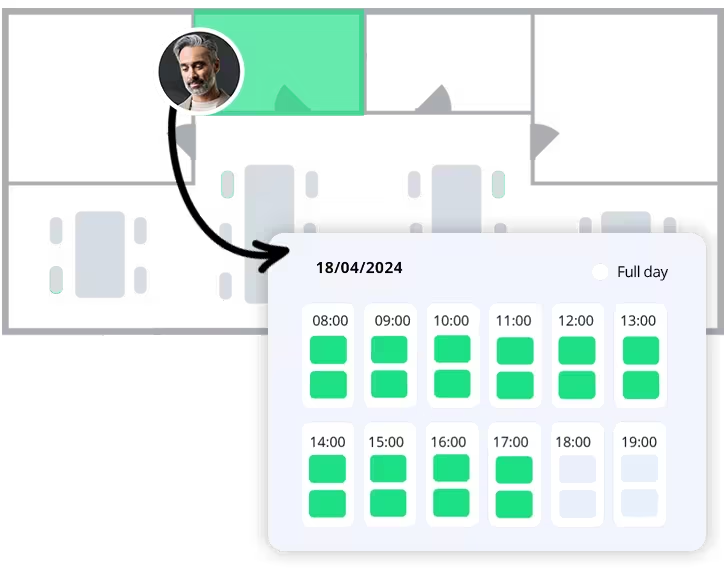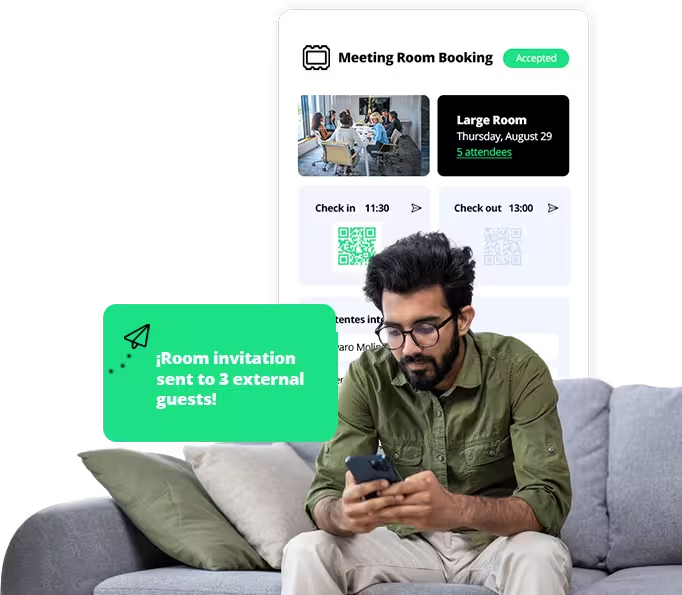
Workplace Management Software
With workplace management software, you can enhance the efficiency of your spaces, boost team productivity, and reduce costs associated with your infrastructure.
Request your demo and discover all the tools.



We answer the most common questions about flexible office booking software so you have no doubts. If you prefer to see it in a demo with a consultant, contact us! We’re here to help!
The term "workplace management" refers to the administration and optimization of a company’s physical environment and resources to enhance employee efficiency, productivity, and well-being. This includes a wide range of activities and responsibilities, such as:
Involves planning and designing the office’s physical space to ensure it is functional, safe, and promotes collaboration and productivity. This includes the layout of desks, meeting rooms, common areas, etc.
Ensuring that the company’s facilities are in good working condition and safe for employees. This may include managing repairs, cleaning, and regular maintenance of equipment and infrastructure.
Administering all resources and equipment needed for daily operations, including office supplies, technology, and furniture. This may also include asset management and planning for replacements or upgrades.
Implementing policies and procedures to ensure a safe and healthy work environment. This includes compliance with safety regulations, emergency management, and promoting employee health and well-being.
Integrating and managing the technologies needed to support productivity and collaboration in the workplace, such as property management systems, space management software, and communication tools.
Implementing practices and policies that promote sustainability, including efficient energy management, recycling, and waste reduction.
Overseeing additional services, such as security, reception, catering, and cleaning, among others, to ensure everything runs smoothly and meets employee needs.
A well-managed work environment can significantly increase employee productivity. Spaces designed to facilitate collaboration, comfortable work areas, and accessible resources allow employees to perform their tasks more efficiently and effectively.
Workplace management directly contributes to employee well-being and satisfaction. A comfortable, safe, and healthy work environment reduces stress and burnout, improving morale and employee engagement. Pleasant and well-maintained spaces can also reduce absenteeism and staff turnover.
In a competitive job market, companies that offer an attractive and modern work environment have an edge in attracting and retaining talent. Employees value well-managed facilities and workspaces that support their comfort and well-being.
Good workplace management ensures that company resources, both physical and technological, are used efficiently. This includes optimizing space to avoid waste and correctly allocating resources, which can lead to significant cost savings for the organization.
A key aspect of workplace management is ensuring compliance with all safety and occupational health regulations. This not only protects employees from potential accidents or illnesses but also shields the company from potential lawsuits and penalties.
The design and management of the workspace can reflect and reinforce a company’s corporate culture. Open and collaborative spaces can foster a culture of open communication and teamwork, while private areas may be important for tasks requiring concentration and privacy.
Efficient workplace management can contribute to a company’s sustainability goals. Implementing energy-saving practices, recycling, and resource-efficient use not only helps reduce costs but also improves corporate image and fulfills the company’s social responsibility.
In a constantly changing business environment, a well-managed workplace can quickly adapt to new needs, such as organizational changes, team expansions, or the adoption of new technologies. This facilitates flexibility and responsiveness within the company.
A modern, well-designed, and well-maintained workplace reflects professionalism and can impress clients, business partners, and visitors. First impressions count, and a well-managed work environment can enhance the company’s reputation.
Workplace management is crucial for creating an efficient, productive, and pleasant environment for both employees and visitors. Improving this management involves adopting strategies and practices that optimize the use of physical, technological, and human resources. Here are some ways to improve workplace management:
Workplace management encompasses a wide range of activities and responsibilities, and effectively managing these can present several challenges. Here are some of the main challenges faced in workplace management:
Ensuring that office space is utilized efficiently can be a major challenge. Poorly managed or underutilized spaces can lead to wasted resources and increased costs. Balancing the needs of different departments and teams while optimizing space use requires careful planning and constant adjustment.
Incorporating and managing new technologies can be complex. Ensuring that all systems work together seamlessly, and that employees are trained to use them effectively, requires significant time and investment. Additionally, keeping up with rapidly evolving technology can be challenging.
Understanding and addressing the diverse needs and preferences of employees can be difficult. Balancing personal comfort with the requirements of collaboration and productivity can involve complex decisions and trade-offs.
Regular maintenance and timely repairs are essential to ensure a safe and functional work environment. Managing these tasks efficiently, especially in larger facilities, can be challenging and may require dedicated resources and staff.
Adhering to health and safety regulations is critical, but ensuring full compliance can be complex and time-consuming. This includes regular inspections, managing safety protocols, and addressing any potential hazards promptly.
Implementing and maintaining sustainability practices can be challenging. It requires balancing cost with environmental impact and ensuring that all stakeholders are on board with sustainability initiatives.
Managing workplace resources within a set budget can be challenging. Allocating funds for maintenance, upgrades, and employee amenities while staying within budget requires careful financial planning and prioritization.
The business environment is constantly evolving, and workplace management must adapt accordingly. Managing transitions, such as organizational changes or shifts in work practices, can be challenging and may require adjustments in space and resource management.
Maintaining high levels of employee engagement and satisfaction requires ongoing effort. Understanding what contributes to a positive work environment and addressing any issues that arise is crucial for ensuring a productive and happy workforce.
Choosing the right workplace management software is crucial for optimizing space utilization, resource management, and overall operational efficiency. Here are some key factors to consider when selecting workplace management software:
Evaluate the features offered by the software and ensure they align with your organization’s needs. Key functionalities to look for include:
The software should be user-friendly and intuitive. A complex interface can hinder adoption and reduce efficiency. Look for software with a clean, easy-to-navigate interface and consider providing training for employees.
Ensure the software can integrate with other systems used by your organization, such as HR systems, financial systems, and communication tools. Seamless integration helps streamline processes and avoid data silos.
Choose software that can scale with your organization’s growth. It should be able to accommodate additional users, spaces, and features as your needs evolve.
Check the level of support and training provided by the software vendor. Access to customer support, documentation, and training resources can help ensure a smooth implementation and ongoing use of the software.
Consider the total cost of ownership, including licensing fees, implementation costs, and ongoing maintenance and support. Ensure the software fits within your budget while providing the necessary features and benefits.
Verify that the software adheres to security standards and compliance requirements relevant to your industry. Protecting sensitive data and ensuring regulatory compliance are critical factors.
Look for reviews and references from other organizations that have used the software. User feedback can provide insights into the software’s performance, reliability, and customer support.
Determine whether the software can be customized to meet your specific needs. Customization options can help tailor the software to fit your organization’s unique requirements and workflows.